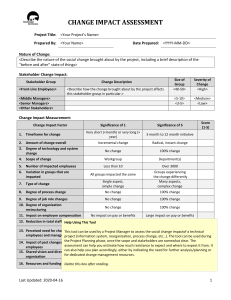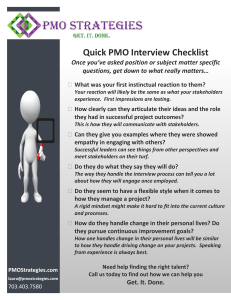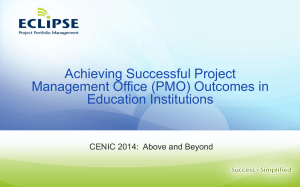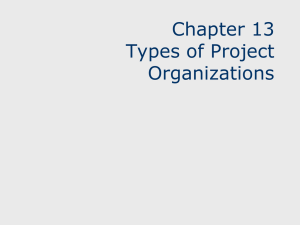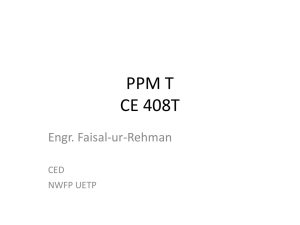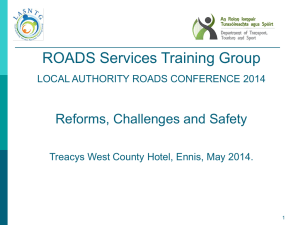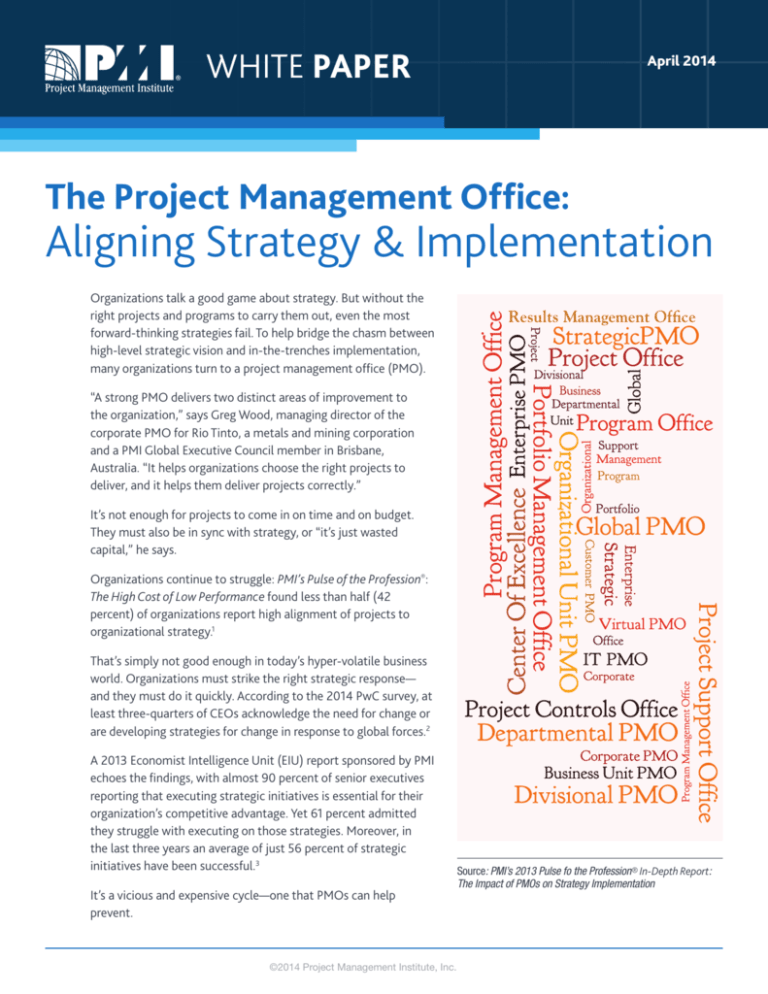
WHITE PAPER
April 2014
The Project Management Office:
Aligning Strategy & Implementation
Organizations talk a good game about strategy. But without the
right projects and programs to carry them out, even the most
forward-thinking strategies fail. To help bridge the chasm between
high-level strategic vision and in-the-trenches implementation,
many organizations turn to a project management office (PMO).
Results Management Office
“A strong PMO delivers two distinct areas of improvement to
the organization,” says Greg Wood, managing director of the
corporate PMO for Rio Tinto, a metals and mining corporation
and a PMI Global Executive Council member in Brisbane,
Australia. “It helps organizations choose the right projects to
deliver, and it helps them deliver projects correctly.”
It’s not enough for projects to come in on time and on budget.
They must also be in sync with strategy, or “it’s just wasted
capital,” he says.
Organizations continue to struggle: PMI’s Pulse of the Profession®:
The High Cost of Low Performance found less than half (42
percent) of organizations report high alignment of projects to
organizational strategy.1
That’s simply not good enough in today’s hyper-volatile business
world. Organizations must strike the right strategic response—
and they must do it quickly. According to the 2014 PwC survey, at
least three-quarters of CEOs acknowledge the need for change or
are developing strategies for change in response to global forces.2
A 2013 Economist Intelligence Unit (EIU) report sponsored by PMI
echoes the findings, with almost 90 percent of senior executives
reporting that executing strategic initiatives is essential for their
organization’s competitive advantage. Yet 61 percent admitted
they struggle with executing on those strategies. Moreover, in
the last three years an average of just 56 percent of strategic
initiatives have been successful.3
It’s a vicious and expensive cycle—one that PMOs can help
prevent.
©2014 Project Management Institute, Inc.
Source: PMI’s 2013 Pulse fo the Profession® In-Depth Report:
The Impact of PMOs on Strategy Implementation
The Project Management Office: Aligning Strategy & Implementation
April 2014
PMOs deliver an average of
US$71 million
to organizations in the form of
revenue or cost reductions.
Source: PMI’s Pulse of the Profession® In-Depth Report:
The Impact of PMOs on Strategy Implementationiv
That value takes many forms. Sometimes it’s the PMO’s ability to establish the processes that enable a major
change initiative to deliver results right out of the gate—and into the future. Sometimes it’s building the talent
that knows when to pass on a pricey megaproject that’s not in line with strategy. Other times, it’s the PMO
drawing on years of rich project performance data to prove a knowledgeable—and objective—voice.
“No other group in the organization understands the real project issues the organization faces more than the
PMO,” Mr. Wood says. “If executives want to know the truth about projects and the people responsible for them,
the PMO is who they should ask.”
2
©2014 Project Management Institute, Inc.
The Project Management Office: Aligning Strategy & Implementation
April 2014
CASESTUDY PMO IN ACTION
Organization: Verizon Wireless, New York, New York, USA
Industry: Mobile network operations
Lesson Learned: A PMO delivers business results by not only improving the performance of its projects but
making sure those projects sync with strategy
When Verizon Wireless, a PMI Global Executive Council member, launched its first PMO in 2005, the new team
had few roadmaps to follow. The company had some project management practices in place, but no way of
knowing if its projects were helping to achieve its strategic goals.
“At the time, no one had an objective view of what was going on,” says Cara Washington, PMO director for the
company’s marketing department, New York, New York, USA. “There was no system in place to say, ‘These are
the projects we need to do to meet our objectives,’ which meant the loudest voice in the room got his or her
project approved.”
These days, the PMO assesses a project’s business case with a one-to-four scoring system that quantifies how
strongly it aligns with strategic goals. “We are smarter about which projects we put forward and about not
supporting projects that don’t meet those criteria,” says Ms. Washington.
The PMO also assigns project managers to projects as soon
as they’re approved to ensure engagement in planning and
decision-making from the outset.
The PMO’s push for strategic alignment ensures projects
help the company achieve its business goals. And, she says,
as Verizon’s strategies have changed over the years, so too
have the PMO’s. The company’s current focus, for example, is
on reducing project cycle times. And backed by standardized
project management processes, teams are delivering real
results.
When I first started the PMO, it
took 18 to 24 months to get a
product out the door. Now we’re
down to 10.3 months.
~~ Cara Washington, PMO Director
Verizon Wireless
New York, New York, USA
©2014 Project Management Institute, Inc.
3
The Project Management Office: Aligning Strategy & Implementation
April 2014
RIGHT TIME, RIGHT TYPE
Not every organization needs a PMO, of course, but certain signs could indicate it’s time to consider one. If an
organization struggles to deliver high-performance projects, that’s one clear indicator, says Luis Fernando Torres,
PMP, founder and partner-director of project management training firm 2Towers: Treinamento & Tecnologia, São
Paulo, Brazil.
Yet that’s not the only flag. An organization flush with project successes might still benefit from a PMO if:
■■ The organization lacks uniform management and oversight processes
■■ Leadership has trouble gathering information about project progress and results
■■ Project goals consistently don’t align with business goals
If an organization decides to establish a PMO, there’s no one-size-fits-all solution. PMI’s Pulse of the Profession:
PMO Frameworks outlines five of the most common5:
1. Business unit PMO: Provides project-related services to support a division within an organization
2. Project-specific PMO: Offers project-related services as a temporary entity to support a specific project or
program
3. Project support controls office: Initiates processes to continuously support the management of an
organization’s projects, programs or portfolios
4. Enterprise PMO: Responsible for the alignment of projects and programs to corporate strategy
5. PMO center of excellence: Supports project work by equipping the organization with standards and tools
to better deliver projects
Fujitsu UK&I, a PMI Global Executive Council member, relies on multiple PMOs, including one at the senior
management level. That PMO is responsible for setting the organization’s project management strategy and
focusing on process improvements related to organizational goals, such as growing the business, moving into
new markets and increasing social responsibility.
In a sizable organization, if the
PMO is too high-level, it can
be hard to manage day-to-day
project issues. Having business
unit PMOs enables us to get a
handle on all of our projects at
the right level.
~~ Paul Jones, Head of PMO
Fujitsu UK&I
London, England
4
“Most of our projects are customer-facing, so our strategic
alignment comes from ensuring that we help deliver business
benefits for our customers and that they are happy with the
projects we deliver,” says Paul Jones, head of the PMO for the
London, England-based branch of the global information and
communication technology company.
Fujitsu also has PMOs in all of its major business units to
ensure they adhere to governance and standards and that
their projects meet schedule, budget and quality goals. For
a large company like Fujitsu, which at any time may have up
to 800 projects worth £600 million, such a network of PMOs
helps keep things manageable.
©2014 Project Management Institute, Inc.
The Project Management Office: Aligning Strategy & Implementation
April 2014
FROM THE TOP DOWN
No matter its structure, a PMO without executive support probably won’t get very far. “If the executive team
is secretive and unwilling to engage the PMO in strategic planning, it makes it much harder for the PMO to add
value to the organization,” says 2Towers’ Mr. Torres.
Those PMOs considered highly effective at driving business growth report directly to someone in the executive
suite, according to Forrester Consulting’s “Strategic PMOs Play a Vital Role in Driving Business Outcomes”, a
research study commissioned by PMI.vi The report also found that the majority of the PMO leaders interviewed
have highly visible sponsorship at the C-level.
“If organizations want to get the most value out of a PMO, they must put it at the strategic level, so it is close
enough to senior management to help it make the best project decisions for the business,” says Piotr Stachowicz,
PMP, senior vice president at PMI Global Executive Council member Citi.
The Economist Intelligence Unit report reinforced the need for support from the corner office. It found the top
reasons for the success of strategic initiatives are leadership buy-in and support. Yet only half of those surveyed
said that strategy implementation as a whole receives appropriate C-suite attention.
Rio Tinto decided it needed a PMO based on a consulting group’s recommendation. The company’s management
put Mr. Wood in charge, but he wasn’t assigned an executive sponsor. That meant he and his team had to secure
buy-in from the rest of the organization largely on their own.
They spent three years building the company’s capital management processes, systems and tools, and making
presentations to business unit leaders that demonstrated the value of a strong project management practice.
Eventually, they won support across many business units and began seeing improvements in project delivery. “It
takes much longer for the PMO to add strategic value when you have to take only a bottom-up approach,” he
says.
©2014 Project Management Institute, Inc.
5
The Project Management Office: Aligning Strategy & Implementation
April 2014
CASESTUDY PMO IN ACTION
Organization: Citi, Warsaw, Poland
Industry: Financial services
Lesson Learned: When strategy shifts, a PMO can help map a way forward.
The leadership team at Citi knows strategic goals must change as the marketplace changes. Global economic
issues and swings in the competitive landscape can alter the company’s business drivers, creating a cascade of
change, large and small, across the portfolio.
As priorities shift, the PMO can be a powerful ally in helping executives decide which projects to launch,
accelerate, delay or shut down. “That’s why it is so important for the PMO to be at as high a level as possible and
to have senior-level sponsors,” says Citi’s Mr. Stachowicz.
In the financial industry, for example, new rules and regulations often force companies like Citi to quickly
reprioritize its investments. “We can’t afford to risk missing a regulation deadline, so there is no question that
those projects are the highest priority,” he says.
When such a change occurs, resources dedicated to other projects may need to be reallocated. If a regulatory
project requires IT expertise, for example, an internal IT project might be shelved so its team members can
support the new initiative. “The PMO works with the business to figure out how we can make room for that
regulatory project with minimal impact to the organization,” Mr. Stachowicz says.
The PMO looks at each project’s expected, measurable value and its alignment with one or more of the
company’s strategic goals: improving service quality, driving financial performance, supporting innovation,
reducing risks and improving the corporate culture.
Projects that don’t measure up are likely to be the first to lose resources. “It’s challenging, given Citi’s
geographical presence and scale of business, to say, ‘This project is more important than that one,’” but those
tough calls are just part of the job, he says.
6
©2014 Project Management Institute, Inc.
The Project Management Office: Aligning Strategy & Implementation
April 2014
ALL-STAR TEAM
A PMO’s processes mean little without the right talent. High-performing PMOs are more than twice as likely
as low performers to have the right skills base (58 percent versus 27 percent) and are much more likely to have
adequate numbers of people (42 percent versus 24 percent), according to the Pulse in-depth report on PMOs
and strategic implementation.
And when organizations fail to invest in that talent, projects suffer—and so does strategy. More than a third of
respondents to the Pulse in-depth report say insufficient human resources (both in terms of raw numbers and
appropriate level of training) is one of the biggest barriers to successful strategy implementation.
As a foundation, PMO staffers must understand all of the core project management tools and practices.
Rio Tinto’s Mr. Wood recommends organizations look for project talent adept at cost control, planning and
scheduling, cost estimating, contract management, risk management and project procurement.
PMO staffers must also have strong business acumen, leadership and decision-making skills, advises Mr. Torres. If
not, organizations risk staffing a PMO with staff adept at day-to-day tasks but unable to understand the broader
strategic impact of their work.
It’s a perilous gap given the growing demands on PMOs.
Unlike an organization’s other project practitioners, the
PMO team doesn’t just adhere to core project management
practices. It makes sure those processes, policies, training,
communication and reporting requirements result in projects
that meet schedule and budget goals as well as produce
business value, says Krissy Wolle, PMP, PgMP, IT portfolio
lead and director of operations in the enterprise PMO at
Optum Technology, Plymouth, Minnesota, USA.
PMO staff must lead the way in helping teams understand
the organization’s strategic goals and equipping them with
the tools to deliver projects and programs aligned with those
goals.
The holy grail is a PMO staffer
who can seamlessly switch
between operations and
execution, theory and practice,
delivering work and leading
others to deliver work.
~~ Krissy Wolle, PMP, PgMP
IT Portfolio Lead and Director of Operations
Optum Technology
Plymouth, Minnesota, USA
©2014 Project Management Institute, Inc.
7
The Project Management Office: Aligning Strategy & Implementation
April 2014
MEASURING VALUE
With the right processes and the right talent in place, a PMO may be fairly confident it’s getting the job done.
But the only way to really tell is through the metrics, the lifeblood of a PMO.
“The reason the PMO exists is to improve capital performance,” Mr. Wood says. At the very least, metrics
should track capital performance across the organization at both the project and portfolio level, with highlights
reported to senior management, he says.
Armed with that data, executives can pit current trends against the organization’s long-term performance.
But the most worthwhile comparisons aren’t limited to within the company walls. PMOs should also consider
benchmarking themselves against other organizations, Mr. Wood says. “Metrics on their own are OK, but to be
effective you need to know where you sit against your peers.”
And PMOs should be looking beyond budget, scope and schedule to business-driven metrics, such as time to
delivery and customer satisfaction. Almost one half of high-performing PMOs measure themselves by criteria
other than simple project metrics, according to the Pulse in-depth PMO report. The high performers’ assessment
process regularly includes feedback from customers (76 percent), project owners (61 percent) and other
stakeholders (60 percent).
The key for the PMO is to look
at the organization’s strategy
and values, and set metrics to
support that.
~~ Piotr Stachowicz, PMP
Senior Vice President, Citi
Warsaw, Poland
8
One of Citi’s current strategic goals, for example, is to rein
in budgets. In aiming to optimize cost structures while
bolstering efficiency, he says, the PMO is considering projects
to reduce the number of data centers or to virtualize servers.
“These examples are ideas related to strategic execution,” he
says, moving the needle on metrics that correlate directly to
the organization’s strategic vision.
©2014 Project Management Institute, Inc.
The Project Management Office: Aligning Strategy & Implementation
April 2014
CASESTUDY PMO IN ACTION
Organization: Optum Technology, Plymouth, Minnesota, USA
Industry: Healthcare
Lesson Learned: A PMO delivers business value by consistently measuring project progress against strategic
goals.
Optum Technology is looking to gain efficiencies by cutting the time it takes to deliver IT projects. To achieve
that goal, the PMO team focuses on cycle time right from the start—scrutinizing schedules and looking for spots
where tasks can be completed more quickly. Once the project launches, it tracks the project metrics that directly
impact cycle time, including whether teams complete estimates and deliver artifacts on time, and when and
whether requirements are met.
While the PMO relies on metrics to demonstrate value, it
also makes sure they don’t get in the way of performance.
For example, PMO staffers knew that to improve overall
efficiency—and thereby reduce cycle time—teams needed
to be better at estimating the time it takes to deliver each
task. A jump in forecasting accuracy would help the PMO
eliminate overruns, streamline the schedule and set shorter
turnaround goals with more confidence.
So Ms. Wolle’s team aligned estimating criteria with annual
budget goals and set metrics at every project milestone
to measure that alignment. But when her team executed
the new tracking system, it discovered that the strict
requirements actually hurt budget forecasting.
The metrics help us identify what’s
working and determine where
problems are that are impacting
cycle time so we can address
them.
~~ Krissy Wolle, PMP, PgMP
IT Portfolio Lead and Director of
Operations
Optum Technology
Plymouth, Minnesota, USA
“If a project team adjusted its hours or budget in response to a necessary change, it got dinged on its estimating
accuracy,” she says. So teams began to pad their estimates. When the PMO realized the estimating metrics
interfered with the more important forecasting objectives, it adjusted priorities to focus on forecasting accuracy.
“Now the forecasting accuracy is improving, which we predict will lead to better results,” she says.
The takeaway is clear: “Make sure whatever you measure is tied to the highest-level priorities,” Ms. Wolle
says. And make sure everyone involved grasps the strategic value of metrics—and the project. “People want to
understand how their individual contribution impacts the larger organization.”
©2014 Project Management Institute, Inc.
9
The Project Management Office: Aligning Strategy & Implementation
April 2014
SUMMARY
Not every organization needs a PMO—and creating one isn’t an immediate salve to heal project and program
woes. The Pulse in-depth report on PMOs revealed that just 33 percent of respondents said their organization’s
PMO has realized its full potential in contributing business value to the organization.
To fulfill that potential, the PMO must ensure that the organization invests in—and delivers on—the projects and
programs that will drive its strategic vision.
Full Potential
The PMO takes an active part by
defining and planning the project
pipeline, securing resources
and regularly monitoring and
reporting progress.
~~ Piotr Stachowicz, PMP
Senior Vice President, Citi
Warsaw, Poland
33%
Source: PMI’s 2013 Pulse fo the Profession® In-Depth
Report: The Impact of PMOs on Strategy Implementation
10
©2014 Project Management Institute, Inc.
The Project Management Office: Aligning Strategy & Implementation
April 2014
REFERENCES
1.
Pulse of the Profession: The High Cost of Low Performance, PMI, 2014. Results based on feedback and insights from 2,500 project
management leaders and practitioners from around the world.
2.
17th Annual Global CEO Survey: Fit for the future: Capitalising on global trends, PwC, 2014. Results based on 1,344 quantitative interviews
with CEOs in 68 countries worldwide.
3.
Why Good Strategies Fail: Lessons for the C-suite, Economist Intelligence Unit, sponsored by PMI, 2013. Results based on a global survey of
587 senior executives and a series of in-depth interviews with senior executives and academics.
4.
Pulse of the Profession In-Depth Report: The Impact of PMOs on Strategy Implementation, PMI, 2013. Results based on research conducted
in July 2013 among 533 PMO leaders who have final decision-making authority for their PMO.
5.
Pulse of the Profession: PMO Frameworks, PMI, 2013.
6.
Strategic PMOs Play a Vital Role in Driving Business Outcomes, Forrester Consulting, a PMI-commissioned research study, 2013. Research
based on in-depth interviews with 40 PMO leaders and executives in July 2013.
©2014 Project Management Institute, Inc.
11
Beijing | Bengaluru | Brussels | Buenos Aires | Dubai | Lelystad | Mumbai | New Delhi
Philadelphia | Porto Alegre | Rio de Janeiro | Shenzhen | Singapore | Washington, DC
PMI.org
Project Management Institute
Global Operations Center
14 Campus Blvd
Newtown Square, PA 19073-3299 USA
Tel: +1 610 356 4600 | Fax: +1 610 356 4647
Email: customercare@pmi.org
©2014 Project Management Institute. All rights reserved. “PMI”, the PMI logo, “Making
project management indispensable for business results” and “Pulse of the Profession”
are marks of Project Management Institute, Inc. For a comprehensive list of PMI marks,
contact the PMI legal department. BRA-110-2014 (04/14)
Making project management
indispensable for business results.®

